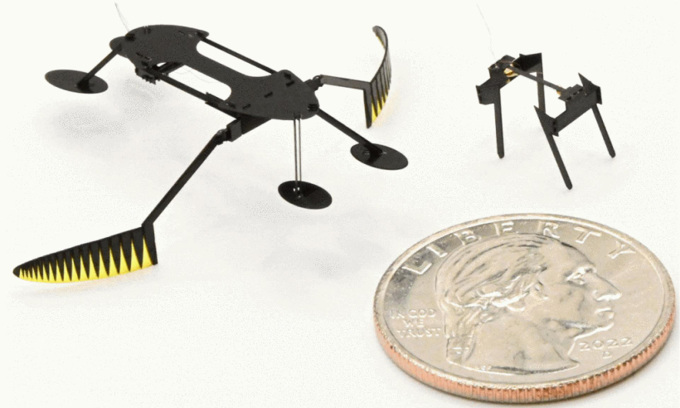In the US, the MiniBug and WaterStrider robots are 8.5 mm and 22 mm long, respectively, and can move at a speed of approximately 6 mm per second.

The WaterStrider robot and MiniBug next to a coin. Photo: Bob Hubner/WSU
A research team at Washington State University has developed two insect-like robots named MiniBug and WaterStrider, TechXplore reported on January 18. They are the smallest, lightest, and fastest working robots of their kind. In the future, these micro-robots could be used for a variety of activities such as artificial pollination, search and rescue, environmental monitoring, micromanufacturing, or surgery.
MiniBug is 8.5 mm long and weighs 8 milligrams, while WaterStrider is 22 mm long and weighs 55 milligrams. Both can move at a speed of about 6 mm per second. While still slower than natural insects, this speed is already fast for micro-robots of similar size, according to Conor Trygstad, a graduate student at the School of Materials Engineering and Mechanics and lead author of the study. A 5-milligram ant can move at a speed of nearly one meter per second.
The key element of these robots is the tiny actuator that allows them to move. Trygstad uses a novel fabrication technique to shrink the actuator down to under one milligram, the smallest ever made. "These are the smallest and fastest actuators ever developed for micro-robots," said Néstor O. Pérez-Arancibia, an expert at the School of Materials and Mechanics Engineering at Washington State University.
The actuator uses a shape-memory alloy, capable of changing shape when heated. The material is called "shape-memory" because it remembers its shape and can then return to its original form. Unlike conventional motors used to power robots, these alloys have no moving or rotating parts.
Shape-memory alloys are typically not used for large robotic movements because they are too slow. But with MiniBug and WaterStrider, the actuators are made of two shape-memory alloy wires with a diameter of just 0.025 mm. With a small electric current, the wires can be heated and cooled easily, allowing the robot to flap its fins or move its legs at speeds up to 40 times per second. In preliminary tests, the actuators were also able to lift objects weighing more than 150 times their own weight.
Thu Thao (According to TechXplore )
Source link


![[Photo] Prime Minister Pham Minh Chinh presides over a meeting on private sector economic development.](/_next/image?url=https%3A%2F%2Fvphoto.vietnam.vn%2Fthumb%2F1200x675%2Fvietnam%2Fresource%2FIMAGE%2F2025%2F12%2F20%2F1766237501876_thiet-ke-chua-co-ten-40-png.webp&w=3840&q=75)











































































































Comment (0)